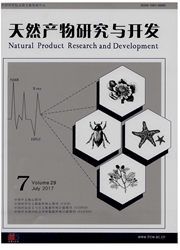

 中文摘要:
中文摘要:
根据加工过程的不同,茶叶可以分为不发酵茶、半发酵茶、全发酵茶。绿茶是典型的不发酵茶,加工过程中,由于高温湿热作用,破坏了茶叶中酶的活性,阻止了茶叶中主要成分的酶性氧化,因此绿茶中含有丰富的次生代谢产物,这些物质不仅赋予了茶叶独有的色、香、味品质,而且与人体健康密切相关。为了建立绿茶水提物中主要次生代谢产物的化合物标准库,本文利用AmberliteXAD-2大孔吸附树脂、硅胶柱色谱及SephadexIM-20凝胶柱色谱分离技术对绿茶水提物中的主要次生代谢产物进行了系统的分离纯化,采用质谱、核磁共振波谱对分离得到的化合物进行了结构鉴定。从绿茶的水提物中分离鉴定了8个化合物,分别是咖啡碱、儿茶素没食子酸酯、表儿茶素、3,5-二羟基-4.甲氧基苯甲酸、山柰酚3-葡萄糖苷、没食子儿茶素没食子酸酯、儿茶素和没食子酸。
 英文摘要:
英文摘要:
Depending on different manufacturing processes, tea can be classified into three major types : ' non-fermented' tea, ' semi-fermented' tea and ' fermented' tea. Green tea is a typical ' non-fermented' tea and is produced by drying and steaming the fresh leaves to deactivate the polyphenol oxidase. Therefore green tea contains abundant secondary me- tabolites,which not only gives the tea itself a unique color, flavor and quality, but also are closely related to human health. In order to establish a compound library of main secondary metabolites of green tea aqueous extracts, Amberlite XAD-2, silica gel and sephadex LH-20 column chromatography were used to separate and purify the main secondary me- tabolites from green tea aqueous extracts. On the basis of mass spectrometry and nuclear magnetic resonance technolo- gies, the chemical structures of the eight purified compounds were elucidated as : caffeine, catechin gaUate, epicatechin, 3,5-dihydroxy-4-methoxy-benzoic acid,kaempferol-3-glucoside,gallocatechin gallate,catechin and gallic acid.
 同期刊论文项目
同期刊论文项目
 同项目期刊论文
同项目期刊论文
 期刊信息
期刊信息
